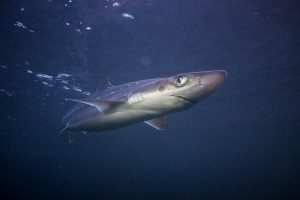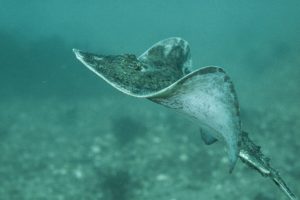Sharks and skates
Cartilaginous fishes (Chondrichthyes) are an ancient group of animals, having changed little in 100 million years. However, in terms of evolution ancient does not mean obsolete, but rather that they hit on a very successful body plan early on. The two modern groups of cartilaginous fishes are rat fishes (Holocephali) and elasmobranchs (Elasmobranchii). The later group is further split into sharks and dogfishes (Selachimorpha), and rays(Rajiformes).
In general the rat fishes are deep sea fishes that prey on benthic animals. They are named so because they do not have a normal caudal fin but a long whip-like tail. The only other group of fishes in Icelandic waters that have a tail like that are the totally unrelated grenadiers (macrouridae). Both groups are mainly found in deep waters south of Iceland.
Rays and skates live on the seafloor and feed on a variety of other benthic animals over a wide depth range. On the other hand, the sharks are usually pelagic top predators also found over a wide depth range. Exceptions occur, as some shark species are strictly benthic and some skate species are pelagic.
Sharks and rays can be found all over the world, but are most common in warm waters. The number of species declines considerably as the waters get colder and in Icelandic waters they are not common by any standards. Only four species have sustained commercial catches on a regular basis: Greenland shark (Somniosus microcephalus), spiny dogfish (Squalus acanthias), common skate (Dipturus batis) and starry ray (Amblyraja radiata). All are found off northern Iceland and two of them, the Greenland shark and the starry ray are quite common.




 This project (EDU-ARCTIC) has received funding from the European Union’s Horizon 2020 research and innovation programme under grant agreement No 710240. The content of the website is the sole responsibility of the Consortium and it does not represent the opinion of the European Commission, and the Commission is not responsible for any use that might be made of information contained.
This project (EDU-ARCTIC) has received funding from the European Union’s Horizon 2020 research and innovation programme under grant agreement No 710240. The content of the website is the sole responsibility of the Consortium and it does not represent the opinion of the European Commission, and the Commission is not responsible for any use that might be made of information contained.